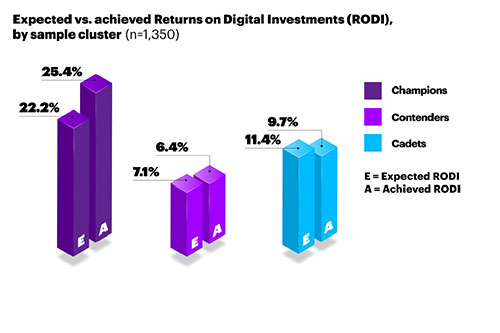April 12, 2019
Today, digitizing manufacturing operations for greater efficiency is not enough. Digital technology has profoundly redefined customer demand and how companies must operate. Customers expect more personalized, fluid experiences that are made possible by smart, connected products that include embedded sensing capabilities; always evolving software; and artificial intelligence (AI).
This era offers extraordinary opportunities for businesses. But, so far, few companies have adjusted their organization to make the most of them. Many continue to embrace traditional ways of making and selling products, limiting their ability to fully capitalize on the promise of emerging digital technologies.
We’re entering a market where static products will no longer be the prime driver of success. So, how should manufacturers prepare for this shift?
First: what does the rise of these new products mean for manufacturers? Simply put: a major step change in both digitization – and in the very ways in which businesses think about, design, manufacture, sell and services products.
So far, the focus of industry digitization has been on the improvement of front- and back-office operations, that is: things like marketing and sales or planning, procurement, finance and HR, and IT. But this focus is shifting. That’s because the “Internet of Things,” sensors, edge computing, and the cloud have enabled engineers to embed compute power, connectivity, and software into almost any kind of hardware product. And this, in turn, allows for the emergence of hyper-personalized product-experiences and as-a-service offerings, all drawing on digital technologies.
The key benefit of this: Manufacturers can finally push beyond old ways of doing things and tap into the full value of digital. By combining digitized business operations and industrial workflows with new kinds of products and services, organizations can improve not just their core efficiencies, but also reinvent themselves continuously to seek out new growth opportunities and digitally-enabled revenue-streams. And: the new products and services will likely enable them to revise, simplify, and digitize their operations even further.
Consider the automotive industry, for example, which is being disrupted by some of these changes already: the rise of connected, electrified vehicles and new offerings like “mobility services” – like digitally enabled car-sharing and ride-hailing – is already changing the industry and creating new opportunities, and forcing the OEMs to review, revise and reinvent the very way in which they operate. And more changes are already on the horizon, brought about by Artificial Intelligence solutions which enable things like the personalization of the in-vehicle-experience, and of course self-driving cars.
Other manufacturers will experience something similar very soon. That’s because the shifts that are currently changing the auto industry will come to sectors like Aerospace and Defense, Consumer Goods, Heavy or Industrial Equipment, too. Among these, five are key:
To manage these shifts, product manufacturers will need to leverage agile, iterative methods with data and insights provided by their own products – much like software companies do. This is another big change to make, of course – and a key requirement for success in the highly digitized “Industry X.0” world of tomorrow.

But it’s not only the products themselves and the ways in which they are made will change – it’s also the very relationship that manufacturers have with the things they create. As products become smart and connected via a stack of digital tech that has become super-cheap, super-easy to use and therefore super-pervasive, companies can no longer simply sell them and be done with it.
Instead, they will have to maintain remote contact and a permanent exchange of data, services, over-the-air updates and upgrades with the “installed base” of their products in the field (again: just like software companies do) – effectively becoming the “managers” of the experiences around these products.
This change in roles gives rise to a series of related shifts: Manufacturers will have to build the capabilities that are required for this kind of minding work. They will have to think about how they can get compensated for this specific service. And they will have to become smart about how they can use the insights they get from their work for either enhancing their existing products and services or for creating new ones.
All of this will require a lot of work, of course (and manufacturers should prepare to take that on). But it will also enable them to pursue strategies which, until very recently, where open only to software- or consumer-internet operations: Building better customer relationships to drive growth, for example, selling as-a-service-offerings, monetizing their “data exhaust” (i.e.: data they always had, but weren’t using), or building platform businesses – all of which can bring much higher growth rates and profits than selling products can.
So, how should manufacturers tackle these challenges – and make the changes they need to make so that they can seize all these opportunities? How can they, in other words, pivot from the old, making-and-selling-things way of doing business, to the new?
The short answer to this is: There are a series of steps that companies should take; these have been proven to work by businesses which have already started their own, product-led digital transformation (like, for example, Haier – the world’s largest maker of “white goods”, which made their home appliance ranges smart and connected. Or Faurecia, an automotive supplier, which is about to revolutionize the car interior by embedding AI and interactive features).
It starts by shaping a clear vision and product strategy around the value that a company is seeking to create. Once this exists, the organization can focus on digitizing its existing core business operations to drive higher operational efficiency to fund the pivot to the ‘new’, for example where the business shifts from selling products to services.
As the new business grows, executives need to ensure that business is also growing its ecosystem and partnerships – which are almost always a key enabler of digital strategies – and ensure that the partner- and customer-experience match where the organisation is headed. Once these steps have been taken, executives can begin to execute the pivot, that is, prudently shift from the old ways of doing business into the new.
All these conceptual steps are, of course, highly specific to a given business; the journey of taking them will vary from company to company. But there are a few best practices which seem to benefit every kind of manufacturing business.
One has to do with focussing on building the key capabilities for product reinvention, like the mastery of data management (which includes things like “digital twins” – digital representations of physical products – and digital threads, i.e. digital representations of said products life cycles), the employment of agile, iterative engineering practices, or the skills required to manage ecosystems and partnerships.
Another has to do with bringing these capabilities into an organization: Many companies are already seeing great results from creating a well-suited digital service factory – a kind of product and experience innovation center that houses all the inter-disciplinary skills required and supplies other lines of the business with new products and services.
All these best practices can be (and have been) explained in very practical ways which should be easy to follow. Which means that, while there’s certainly no one-size-fits-all strategy for taking a manufacturing business all the way from product to business model reinvention, there should be more than enough pointers to allow a company to begin that journey, and then figure out its own way forward.
Reinventing products and, eventually, an entire business is no easy task (Harvard Business School Professor Sunil Gupta has compared it to exchanging the engine of an airplane during flight). But it’s also a feat that’s very well worth taking on: Research suggests that fully digitizing our businesses could create 100 Trillion US dollars in value for both society and business, about two-thirds of which will come from further digitizing operations and customer experiences. And what better, more efficient way to start tapping into this extraordinary reserve than by reimagining and reinventing what’s at the core of these two things, that is: products, and the way in which they create value?
We have everything we need to reinvent the very notion of what things to make and how to make them. All that’s left to do is start doing it – and doing it now.
About the authors
 Eric Schaeffer, eric.schaeffer@accenture.com, is Senior Managing Director at Accenture and leads Accenture’s Products Industry X.0 practice. This brings together services across innovation, engineering and product development, manufacturing and digital operations, and product support services optimization. He is also the Global Lead for automotive, industrial equipment and infrastructure companies for digitally reinventing their businesses and creating new levels of innovation and efficiency across the extended connected value chain.
Eric Schaeffer, eric.schaeffer@accenture.com, is Senior Managing Director at Accenture and leads Accenture’s Products Industry X.0 practice. This brings together services across innovation, engineering and product development, manufacturing and digital operations, and product support services optimization. He is also the Global Lead for automotive, industrial equipment and infrastructure companies for digitally reinventing their businesses and creating new levels of innovation and efficiency across the extended connected value chain.
 David Sovie, david.a.sovie@accenture.com,is Senior Managing Director at Accenture and the Global High Tech Industry Lead. He also leads the Industry X.0 practice for Accenture’s Communications, Media and Technology group, which provides digital transformation services across the product innovation, engineering, manufacturing and product support business functions. His client work focuses on shaping and executing large scale transformation programs for leading technology companies globally.
David Sovie, david.a.sovie@accenture.com,is Senior Managing Director at Accenture and the Global High Tech Industry Lead. He also leads the Industry X.0 practice for Accenture’s Communications, Media and Technology group, which provides digital transformation services across the product innovation, engineering, manufacturing and product support business functions. His client work focuses on shaping and executing large scale transformation programs for leading technology companies globally.
The book Reinventing the Product, by the co-authors Eric Schaeffer and David Sovie, is © 2019. It is designed to help companies master the art of product reinvention and take advantage of the massive value potential fast-advancing digital technologies offer.
[red-button]Download Accenture’s Digital Innovation Report[/red-button]
In this episode, I sat down with Beejan Giga, Director | Partner and Caleb Emerson, Senior Results Manager at Carpedia International. We discussed the insights behind their recent Industry Today article, “Thinking Three Moves Ahead” and together we explored how manufacturers can plan more strategically, align with their suppliers, and build the operational discipline needed to support intentional, sustainable growth. It was a conversation packed with practical perspectives on navigating a fast-changing industry landscape.